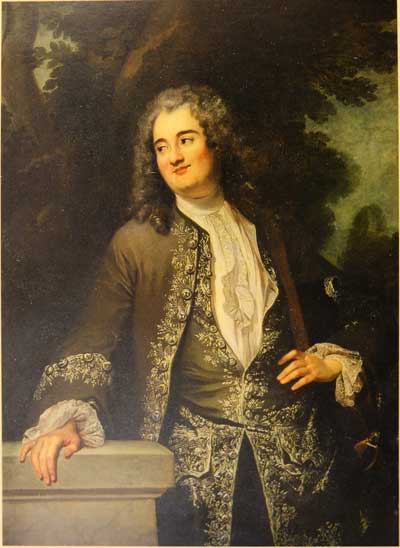
- Home Page
- Accepted
Paintings & Copies - Doubtful
Attributions - Doubtful Textual References
- Alternative
Titles - Collectors &
Museums - Bibliography
- Search Abecedario
- Watteau &
His Circle
X. Jean de Jullienne
Entered January 2017; revised December 2019
Paris, Musée du Louvre, inv. RF 1973 1
Oil on canvas
100.3 x 97 cm
ALTERNATIVE TITLES
Portrait d’un gentilhomme
Portrait presumé de Monsieur Jean de Jullienne
RELATED PRINTS
This portrait was not included in Jullienne’s Oeuvre gravé. It was a puzzling omission for those who believed both in Watteau’s authorship and the sitter's identity as Jullienne.
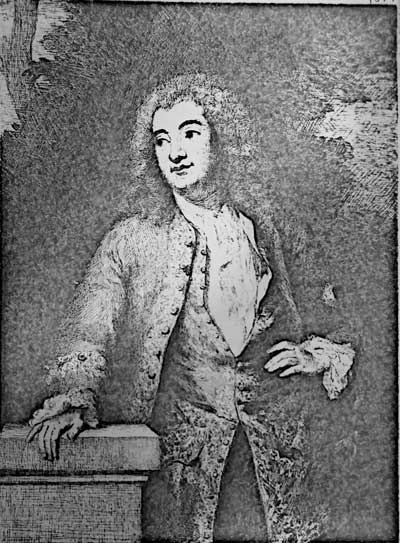
Auguste Boulard fils after “Watteau,” Portrait de Jean de Jullienne, 1877.
The painting was first engraved by Auguste Boulard fils (1852-1927) for Jean-Baptiste Chazaud’s 1877 monographic brochure on the picture.
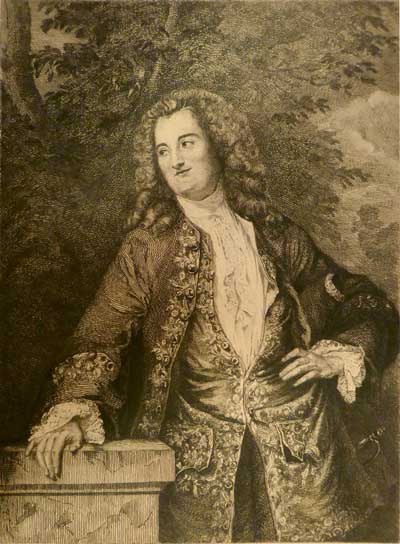
Eugène-André Champollion, M. de Julienne, engraving, 1879.
The portrait was engraved a second time, in 1879 by Eugène-André Champollion (1848-1901), at the time of the Exposition universelle. It was reissued with Mantz’s study of 1892.
PROVENANCE
Paris, with Jules Duclos. Mantz referred to the painting in 1859, describing it only as in private hands and not mentioning Duclos by name, but in 1892 Mantz was explicit in remembering that he had seen it in Duclos’ collection. Edmond de Goncourt described Duclos as a dealer and acknowledged that he knew the portrait, which was coming up at auction from Duclos’ successor.
Paris, sale, c. May 1869, lot 427: “WATTEAU (ANTOINE) . . . Portrait presume de M. de Julienne. Debout dans un parc, il est vu jusqu’à mi-jambes; le main gauche appuyé sur sa hanche, l’autre sur une balustrade en Pierre. Il est vêtu d’un habit marron et d’un gilet gris galonnés d’argent; perruque longue, chapeau jeté sous le bras, jabot et manchettes de dentelle. (H. 1,30.— L. 0,95.) — Collection de M. Duclos.”
Paris, collection of Jean-Baptiste Chazaud. The portrait was presented to the Louvre for consideration on March 13, 1879.
Paris, collection of Camille Groult (1837-1908; heir to a fortune from flour milling). By descent to his son Jean Groult, and then to his grandson Pierre Bordeaux-Groult.
Paris, collection of Mme. A. Her sale, Paris, Palais Galliera, November 20, 1972, lot A: "WATTEAU (Antoine) . . . Portrait présumé de Monsieur Jean de Jullienne, écuyer du roi, chevalier de l’Ordre de Saint Michel. Debout dans un parc, il est vu jusqu’à mi-jambes, la main gauche appuyé sur sa hanche, l’autre sur une balustrade de Pierre. Il est vêtu d’une chemise à jabot et manchettes de dentelle, d’un gilet gris et d’un habit marron richement brodés d’argent. Il est coiffé d’une longue perruque bouclée et tient son chapeau sous le bras gauche. Toile. Haut. 1,300; larg. 0,970
Expositions: Tableaux et dessins de l’École Française du XVIIIe siècle, tirés de collections d’amateurs, boulevard des Italiens, Paris, 1860, no 427. / Exposition Universelle, Palais de Trocadéro, Paris, 1878, no 699. / De Watteau à Prud’hon, Gazette des Beaux-Arts, 140 rue de Faubourg-Saint-Honoré, Paris, du 11 au 31 mai 1956, no 98 du catalogue où il est reproduit. / La France au XVIIIe siècle, Royal Academy of Arts, Londres, no 907 du catalogue.
Ventes: Vente anonyme, 11 mars 1865, no 73. Vente Sandeau [sic], 5 décembre 1872, no 34. Vente Bacqua, 18 février 1873, no 63. Vente du Docteur G. N., 29 mai 1908, no 61. Vente anonyme, 26 mars 1923, no 107.
Bibliographie: J.-B. Chazaud: A. Watteau. Reproduit et gravé par Boulard fils dans une brochure en 1877. Paul Mantz: La Revue française, mars 1859, tome XVI, p. 345; La Gazette, 1878, p. 875; L’Art, 1879, p. 60. Bulletin des Beaux-Arts, 1884-1885, tome II, où il est reproduit à l’eau forte par V. Focillon, p. 103. E. Dacier et Vuaflart: Jean de Jullienne et les graveurs de Watteau, 1922 et 1929, p. 47, no 187, et p. 13. E. Pilon: Watteau et son école. Édition Van Œst, 1912, p. 42. P.[sic] Mathey, Watteau,1959, pp. 14 et 52, nos 143 et 147. H. Jouin, Notice historique et analytique des peintres éxposés au Trocadéro. H. Adhémar: Watteau. Éditions Flammarion no 138. A. Michel: Histoire de l’Art, tome VII, p. 125. Dilke: French portraits of the eighteenth century, p. 87. Dimier: Les portraits français du XVIIIe siècle, tome I, p. 47, no 187. Anciennes collections J.-B. Duclos, J.-B. Chazaud, Camille Groult.
(Voir la reproduction en couleurs sur la couverture.)”An errata page was subsequently added to the printed catalogue: “Rectification: Sous le titre «Ventes» doît être seulement maintenue: Vente anonyme, 11 mars 1865, no 73. Toutes les autres ventes indiquées ne concernent pas le tableau vendu et doivent être supprimées. Addition: Sous le titre «Bibliographie», il faut ajouter: G. Wildenstein: Lancret. Les Beaux Arts, édition d’études et de documents, Paris, 1924. Le portrait de M. de Julienne par Watteau est cité comme étant «le célèbre tableau de Watteau actuellement dans la collection de M. X . . . à Paris» (collection de M. Camille Groult).”
The painting was withdrawn just before the sale and sold to the Louvre for 4,000,000 francs.
EXHIBITIONS
Paris, Galerie Martinet (1860), cat. 427 (by Watteau, Portrait présumé de M. de Jullienne, lent by M. Duclos).
Paris, Exposition universelle, “Portraits historiques” (1878), cat. 699 (by Watteau, Jean de Jullienne, lent by Jean-Baptiste Chazaud).
Paris, Gazette des Beaux-Arts, De Watteau à Prud’hon (1956), cat. 98 (by Watteau, Monsieur de Julienne, lender not designated)
London, Royal Academy, France in the Eighteenth Century (1968), cat. 733 (by Watteau, Portrait of a Man, lent by a French private collector).
Washington, Paris, Berlin, Watteau 1684-1721 (1984), cat. 67 (by Watteau, Portrait of a Gentleman [Portrait d’un gentilhomme], lent by the musée du Louvre).
SELECT BIBLIOGRAPHY
Mantz, “L’Ecole française” (1859), 347.
Thoré-Bürger, “Exposition de tableaux” (1860), 232.
Goncourt, Catalogue raisonné (1875), 28.
Chazaud, Antoine Watteau (1877).
Mantz, “Les Portraits historiques au Trocadero” (1878), 875.
Anonymous, “Guide raisonné de l’amateur et des curieux” (1879), 60.
Fabre, “Tableaux de Watteau” (1884), 111.
Mantz, Watteau (1892), 160.
Dilke, French Painters (1899), 87.
Zimmerman, Watteau (1912), no. 40.
Pilon, Watteau et son école (1912), 41-42.
Michel, Histoire de l’art (1905-29): 6 (1923), 125 n. 1.
Wildenstein, Lancret (1924), cat. 572.
Réau, “Watteau” (1928), cat. 187.
Adhémar, Watteau (1950), 121, cat. 152.
Adhémar, “Watteau et ses amis” (1956), 21.
Mathey, Watteau, peintures réapparues (1959), 14, 52, cat. 143.
Macchia and Montagni, L’opera completa di Watteau (1968), cat. 138.
Ferré, Watteau (1972), cat. B78.
Broglie, “Un 10ème Watteau au Louvre” (1973).
Bazin, “Enquête sur Watteau” (1974), 61.
Demoriane, “Watteau rediscuté” (1974), 94.
Ferré, Lettre ouverte (1975), 84, 90.
Paris, Louvre, Catalogue illustré (1974), cat. 921.
Saint-Paulien, “La Tradition du faux” (1976), 54-55.
Posner, “Un Chef-d’oeuvre de Watteau” (1977), 81-85.
Posner, “Another Look at Watteau’s Gilles“ (1983), 99.
Posner, Watteau (1984), 243-44.
Rosenberg, “Le Recueil de Valenciennes” (1986), 287.
Sembaz, “Le «Portrait d’homme»” (1986), 11.Cuzin, Le Louvre (1989), cat. 58.
Fumaroli, “Une Amitié paradoxale” (1996), 34-37.
Temperini, Watteau (2002), cat. 59.
Glorieux, Watteau (2011), 313-14.
Gimpel, Journal (2011), 46.
Plomp and Sonnabend, Watteau: Der Zeichner (2016), 136-38.
RELATED DRAWINGS
Two drawings have been related to the so-called Jullienne portrait but neither bears close scrutiny. Indeed, as it has become increasingly evident, the painting is not by Watteau, and therefore we should not expect that Watteau made any preparatory studies.
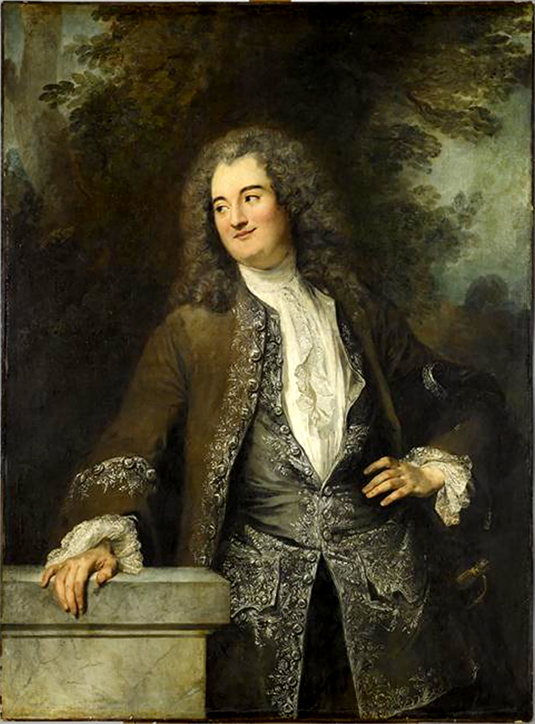
Anonymous French artist, Portrait of a Gentleman.
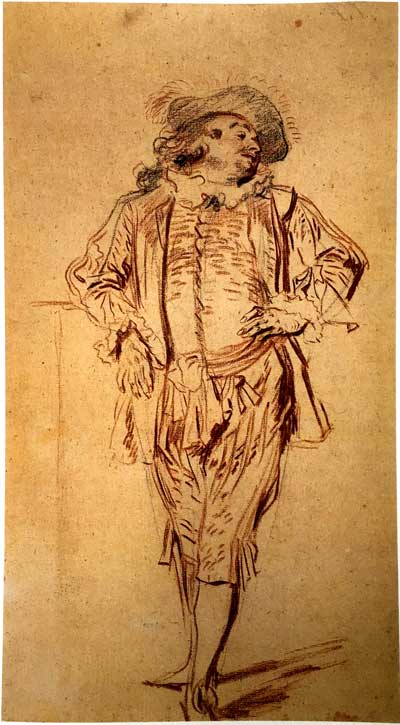
Watteau, Study of a Standing Man (Paul or Philippe Poisson?), red and black chalk, 33.4 x 18.6 cm. London, British Museum.
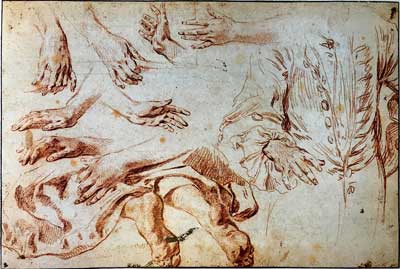
Watteau, Studies of a Man’s Torso, Hands, and Feet, red chalk, 22.7 x 35.2 cm. Paris, musée Jacquemart-André.
The first related drawing is a study of an elegantly posed actor now in the British Museum (Rosenberg and Prat 318). The turn of the head and the positioning of the man’s hands (especially his left hand on his hip) were claimed to be similar to those in the Jullienne portrait but, at best, these elements are only analogous. The drawing is not specifically related to the painted portrait.
The second drawing to be considered, now in the musée Jacquemart-André (Rosenberg and Prat 82), is unusual, if not problematic, because of its format. On the left side are eight studies of hands and two undersides of feet. The overall mise-en-page of these jumbled body parts is quite different from Watteau’s normally judicious placement. The study of the man’s torso is drawn in a more halting manner, perhaps suggesting a difference in time and purpose between the two parts of the sheet. Despite Parker and Mathey’s argument, as well as Rosenberg and Prat’s, the man’s pose corresponds to those in the Louvre painting in only a generic way. True, he has his hand on his hip and his hat under his arm, but these are the reverse of the painting. His jacket is open to reveal his shirt, but the buttoning is different than what is seen in the painting. So too, the arrangement of the lace cuff at the wrist is not the same. The positioning of the right-hand fingers is dissimilar. Equally disconcerting, Rosenberg and Prat would date this drawing to 1714, several years before the painting is thought to have been executed. In short, there is no compelling reason to associate this drawing with the so-called Jullienne portrait. Most importantly, as noted above, as the painting is not by Watteau, why should one expect any preparatory drawings by him?
REMARKS
The attribution of the so-called Jullienne portrait has been contested for a century and a half. For the greater part of the time it has been given to Watteau and has enjoyed a fixed place in his oeuvre. When it first appeared in the mid-nineteenth century, the attribution to Watteau was voiced with confidence. This optimism prevailed at the time of the 1878 Exposition universelle, expressed especially by Paul Mantz. Most late nineteenth-century and early twentieth-century critics continued to attribute it to Watteau, including de Goncourt, Lady Dilke, Pilon, Wildenstein, Réau, and Adhémar. René Gimpel saw the painting in Groult’s home and thought it wonderful, perhaps the only extant portrait by the master. Mathey paid special attention to the portrait, emphasizing how the two Watteau drawings supposedly helped authenticate the attribution.
A new wave of confidence in the attribution arose when the painting was purchased for the Louvre in 1972. Posner, for example, published an inconclusive study of the portrait. It was shown in the tercentenary Watteau exhibition in 1984, and has been discussed by most modern scholars, including Roland Michel, Macchia and Montagni, Cuzin, Fumaroli, Temperini, and Glorieux, all of whom have unconditionally accepted the attribution.
The critics who accepted it into Watteau’s œuvre displayed a strong division as to when he would have painted it. Mathey dated it as early as 1711-12, whereas Adhémar, seconded by Macchia and Montagni, favored 1716. Posner thought it was executed c. 1718 or a little later. Her earlier position notwithstanding, Adhémar also posited that it was painted with the aid of an assistant near the end of the artist’s life, in 1721. Temperini chose a date between 1711 and 1720, that is, at almost any point in the artist’s career.
However, there have always been critics who were dubious about ascribing the portrait to the master. As far back as 1879, the anonymous author of the Guide raisonné de l’amateur et des curieux wrote, “C’est un Lancret, et un merveilleux Lancret.” When the picture entered the Louvre’s collection in 1972, a few dissenting opinions were voiced. One of the strongest rejections came from Germain Bazin, the honorary head curator of the Louvre : “Quand au pseudo-portrait de Jullienne que le Louvre vient d’acquerir, ce tableau, que je connais depuis fort longtemps, m’a paru toujours non seulement n’être pas de la main de Watteau, mais très différent de la «manière» de ce peintre." Even Rosenberg, who had been the curator when the acquisition was made, came to reject the attribution: although he included the portrait in the 1984 Watteau exhibition, his entry expressed doubts about the attribution. Then, two years later, he admitted that he was even more hesitant to accept it. In the 2016-17 exhibition where the Jacquemart-André drawing was included (still attributed to Watteau), the Louvre portrait was attributed to a follower of Watteau and was described just as a portrait of a gentleman.

Anonymous French artist, Portrait of a Gentleman.
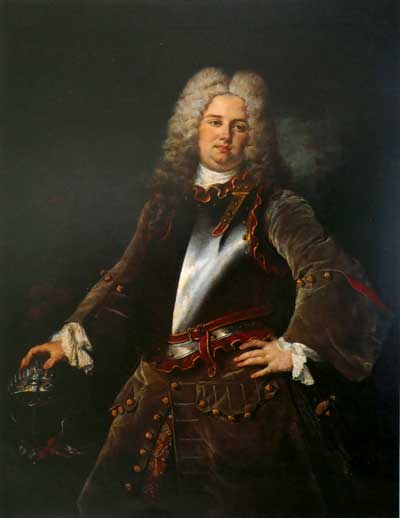
Nicolas de Largillière, Portrait of the Marquis de Rasilly, 1690, oil on canvas, 138 x 103 cm. Chaalis, musée Jacquemart-André.
A number of alternative attributions have been offered. Saint Paulien attributed the picture to Jean François de Troy, the artist responsible for the portrait of Jean de Jullienne now in the Valenciennes museum. Doryck Sembaz (the pseudonym of Jean-Louis Guillemin) reported that some people had proposed the name of Jean-Baptiste Oudry.
Whoever executed the Louvre painting, he must have been well trained in the art of portraiture. This is revealed not only in the fine execution of the facial features and hands, but also the skilled rendering of the silver embroidery and lace. The handling of these elements suggest the work of a professional portraitist, an idea which is reinforced by a comparison with the oeuvre of Nicolas de Largillière (1656-1746). Many of the conventions that he established and that permeated French portraiture for more than a half century are found in the Louvre painting: the convincing rendering of fabrics, the gentle turn of the head, the mannered positioning of the fingers, the gentle, even smiling facial expressions. This is not to suggest that Largillière painted the Louvre picture. Rather, it is to meant to indicate that the artist was probably a trained Parisian portraitist.
The identity of the man portrayed here remains obscure. For those who accepted Watteau’s authorship, the sitter was presumed to be someone in the artist’s circle. When the painting emerged in the mid-nineteenth century, it was claimed that the man was Jean de Jullienne. However, his round face is quite unlike Jullienne’s long, thin face as portrayed by Watteau in Assis au près de toy, by François de Troy in a portrait in the Valenciennes museum,and by Maurice Quentin de la Tour in a pastel at the Fogg Museum. Yet suspicions were already voiced in the mid-nineteenth century. Scholars such as Réau and Adhémar coupled Jullienne’s name with modifying terms such as “supposé” and “dit” to skirt around the issue. By the mid-twentieth century few believed it was actually a portrait of Jullienne, and critics have sought alternatives. Posner and Fumaroli suggested that it portrayed the comte de Caylus, which is not a satisfying solution. Glorieux proposed the name of Jean François Lériget, marquis de La Faye, the owner of Watteau’s La Mariée de village. These identifications are not particularly convincing. But now that the attribution to Watteau has been rejected, we are not restricted to the painter’s circle of friends and patrons. At the 1968 exhibition of French art at the London Royal Academy, the work was listed simply as Portrait of a Man, and it has become increasingly common to refer to the sitter as an unnamed gentleman, a reasonable solution accepted by the Louvre as well.
X. Portrait: Jean de Jullienne (copy 1)
Entered January 2017
Whereabouts unknown
Oil on canvas
125 x 92 cm
PROVENANCE
Paris, sale, March 11, 1865, lot 73: “WATTEAU (A.) . . . Portrait de M. de Julienne. Debout dans un parc, il est vu jusqu’à mi-jambes; le main gauche appuyé sur sa hanche, l’autre sur une balustrade en pierre; il est vêtu d’un habit et d’un gilet galonnés d’argent, le chapeau sous le bras.”
Nantes, sale, February 18, 1843, collection of M. Bacqua, lot 63: “WATTEAU . . . Portrait de M. de Julienne, protecteur de l’artiste.”
Paris, sale, Hôtel Drouot, October 25, 1990, lot 25: “Suiveur d’Antoine WATTEAU / PORTRAIT DE MONSIEUR DE JULIENNE / Toile / Haut.:125 cm Larg.: 92 cm. / 40 000 / (Voir la reproduction) / Reprise du tableau du Louvre.” Sold for 60,000 francs.
REMARKS
This is a straightforward replica of the Louvre painting, executed to the same scale as the original. In 1984, Rosenberg wrote that he had seen this painting in 1973 in a private collection near Paris, and he identified it with the listings in an 1865 anonymous sale, the 1872 Sourdeau sale, and the 1873 Bacqua sale. All three works were described as showing Jean de Jullienne. However, the Sourdeau painting must have been an entirely different composition since it showed the sitter bust-length rather than to the knees, and enveloped in a crimson silk drapery. Given the dearth of information, we cannot be certain that the pictures sold in 1865 and 1873 are to be identified with the one sold in 1990, but, for convenience’ sake, they have been let stand here.
In 1992 when the so-called Portrait of Jullienne in the Louvrecame up at auction, the catalogue at first claimed that it had been in the 1865 Sourdeau, and Bacqua sales but later withdrew that provenance.
X. Portrait: Jean de Jullienne (copy 2)
Entered January 2017

Whereabouts unknown
Oil on canvas
85 x 64 cm
PROVENANCE
Paris, Hôtel Drouot, anonymous sale, June 9, 1909, lot 20: “Attribué à Lancret . . . A mi-corps, de trois quarts à droite, perruque basse, à boucles, poudrée, habit noir, déboutonné sur une chemise festonnée; le bras droit appuyé sur un balcon de pierre; à droite, pan de draperie rouge. Toile. Ovale. 85 x 64 cm.” Sold for 380 francs.
SELECT BIBLIOGRAPHY
Wildenstein, Lancret (1924), cat. 573.
REMARKS
The description of the sitter as a man with a large periwig, turning sideward, his jacket unbuttoned and revealing the shirt, his right hand resting on a balcony—all fits the composition of the Louvre portrait. Wildenstein seems to have recognized this and accordingly listed it immediately after his entry for that painting (included only because a critic in 1878 had thought the Louvre painting was by Lancret). Yet, curiously, Wildenstein did not go the necessary step forward and declare the painting sold in 1909 to be a copy after the Louvre painting.
There were some divergences from the Louvre model, notably the inclusion of red drapery at the right and the adaptation of the rectangular portrait to an oval format. Any further discussion must be tabled until we see the painting itself or, at least, an image of it.
